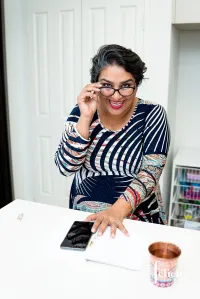
Whose Boundaries are these anyway ?
“Whose boundaries are these anyway?”
When culture, gender and caregiving collide, the conversation on ‘boundaries’ needs a damn overhaul.
Let’s get honest
“Just set better boundaries.” That’s what they say.
As if it’s that simple. As if we haven’t been raised to never inconvenience others. As if our very survival—in families, workplaces, communities—hasn’t depended on how much we tolerate, how quietly we endure, how available we are.
Let’s be real:
Setting boundaries is hard enough when you’re a woman.
It’s even harder when you’re a parent.
And it’s next-level complicated when you’re from a culture where gender equality isn’t just lagging—it was never fully coded into the system to begin with.
In those contexts, boundaries aren’t just a personal development skill. They’re a radical act.
The data doesn’t lie (BUT it doesn’t tell the whole story either)
Here’s what we know:
Globally, women perform 76.2% of unpaid care work—three times more than men.
(International Labour Organization, 2018)Mothers face a 40% wage penalty over their careers compared to childless women.
(Institute for Fiscal Studies, UK)Women of colour report higher levels of burnout, microaggressions, and cultural expectation conflict when trying to assert boundaries in the workplace.
(LeanIn.Org & McKinsey, 2023)
But here’s what those numbers don’t show:
The guilt.
The family backlash.
The religious or cultural conditioning that says “good daughters don’t say no.”
The fear of being seen as selfish, difficult, or—gasp—too Western.
It’s one thing to attend a boundary-setting workshop. It’s another to say “I need time for myself” in a household where selflessness is a virtue and silence is mistaken for strength.
In many communities—South Asian, Middle Eastern, African, Pacific Islander, Latinx—the idea of personal boundaries bumps up against deep values like duty, loyalty, obedience, and collectivism.
And when collectivism is coded female? Guess who ends up carrying the emotional, social, and practical load?
Women.
We’re the emotional shock absorbers, the go-betweens, the ones expected to hold everyone else’s chaos. Saying “no” in that context isn’t self-care. It’s seen as betrayal.
Worse still, when women from these backgrounds do assert needs or limitations, they’re often judged—both from within their communities (“she’s too Western now”) and outside of them (“she’s not assertive enough”).
We can’t win. Because the game was never built for us.
Let’s talk about the motherhood angle.
Boundaries? What boundaries?
The minute you become a mother, especially in a migrant, working-class, or culturally conservative context, the expectation is that your needs vanish.
You’re the village.
You’re the fallback plan.
You’re the one keeping everyone fed, clothed, bathed, transported, emotionally regulated, and—if you’re lucky—barely sane.
And if you do try to reclaim time or space for yourself? You’re seen as less committed, less available, less motherly.
There’s no room to breathe.
Because parenting isn’t supported structurally—it’s outsourced to women and romanticised as sacrifice.
So what now?
Let’s be real: We don’t need more workshops that tell us to “just say no.”
We need frameworks that work with our realities, not against them.
Here are some out-of-the-box, culturally conscious ways to think about boundaries:
1. Reframe boundaries as 'Collective Care'
Instead of “protect your energy,” try: “How do we build systems of shared responsibility, so no one burns out?”
Boundaries can be community-minded, not just individual. Think: role rotation, co-care agreements, “rest clubs” with other mothers.
2. Adapt boundaries to 'Culture, Not Erase Culture'
Translate the concept of boundaries into language your family understands. Try:
“Let’s create routines that work for everyone.”
“I’m doing this so I can show up better for you.”
“I’m still here. I’m just taking a pause.”
Sometimes, it’s not what you say—it’s how you say it.
3. Small disruptions matter
Start tiny. You don’t need to stage a dramatic revolution.Try:
Leaving a gathering early.
Asking your partner to handle bedtime twice a week.
Not answering that call immediately.
Build the muscle. Rewire the story.
4. Teach the next generation differently
Model boundaries with love.Say:
“Mumma/Mom/Amma needs a moment right now.”
“I love you, and I’m not available to talk just yet.”
Let your kids see what it looks like to honour yourself—without shame.
5. De-colonise the damn concept
Boundaries don’t have to be cold or rigid.They can be fluid, responsive, and rooted in relational integrity.
Let’s not copy-paste white feminism’s idea of “me first.” Let’s build boundaries that honour where we come from—and still leave room to grow.
If you’ve ever struggled with setting boundaries, it’s not because you’re weak. It’s because you were never taught how—especially in a world that benefits from your over-functioning.
But here’s the thing:
You get to redefine what boundaries look like for you.They can be messy, tender, quiet, powerful.
They can be cultural and radical. Gentle and firm. Sacred and necessary.
You’re allowed to take up space.
You’re allowed to rest.
You’re allowed to say: “I matter too.”
Let’s stop asking if we deserve boundaries—and start building systems that make them possible.
Get in touch via these options,together, we’ll create a path that honors your goals and your well-being. :
Reach out to me at [email protected]
Learn more about my work at UnmutingYou.com
Or connect with me directly on LinkedIn
In the spirit of unity and respect, I acknowledge and pay my heartfelt respect to the traditional custodians of Whadjak country, the Noongar people.
I stand on this ancient land with deep appreciation for their enduring connection to country, culture, and community.
As we gather and work together, may we honor the wisdom of the Noongar elders, past, present, and emerging, and strive to nurture a harmonious relationship with the land, its stories, and its people.


LinkedIn